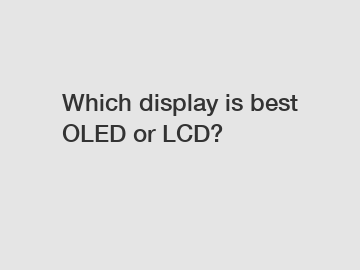Which display is best OLED or LCD?
Which display is best OLED or LCD?
When it comes to choosing a display for your device, there are two main options on the market – OLED (Organic Light Emitting Diode) and LCD (Liquid Crystal Display). Each of these technologies has its own strengths and weaknesses, and the choice ultimately depends on your specific needs and preferences. In this article, we will discuss the differences between OLED and LCD displays to help you decide which one is best for you.
Picture Quality.

One of the most important factors to consider when choosing a display is picture quality. OLED displays have an advantage over LCD displays in this area. OLED technology allows for individually lit pixels, which results in perfect black levels, vibrant colors, and infinite contrast ratios. This means that OLED screens can display deep blacks and bright whites simultaneously, creating a more immersive viewing experience. On the other hand, LCD displays produce backlight through a separate layer, which can lead to light leakage and less accurate color reproduction.
Energy Efficiency.
Energy efficiency is another aspect to consider, especially if you want to extend your device's battery life. In this area, LCD displays have the upper hand. Unlike OLED screens, LCD displays require a backlight to illuminate the pixels, but this backlight can be adjusted to different levels of brightness. OLED displays, on the other hand, do not require a backlight, as each pixel emits its own light. While this allows for better picture quality, it also means that OLED displays consume more energy when displaying bright content.
Durability.
Durability is an essential consideration for displays, as they are prone to scratches and damage. LCD displays tend to be more resistant to damage than OLED displays. LCD screens have a solid glass panel that protects the liquid crystals, making them less likely to crack or break upon impact. OLED displays, on the other hand, have a fragile organic material layer, which can be easily damaged by excessive pressure. Additionally, OLED displays are more susceptible to burn-in, where a static image is displayed for an extended period, resulting in permanent damage to the screen.
Viewing Angle.
The viewing angle is an important factor if you frequently share your device's screen with others. OLED displays offer better viewing angles compared to LCD displays. With OLED technology, the colors and contrast remain consistent, regardless of the angle at which you view the screen. On the other hand, LCD displays often suffer from color shifting and contrast loss when viewed from an angle. This means that with an OLED display, you can enjoy a high-quality image from almost any angle.
Conclusion.
In conclusion, both OLED and LCD displays have their own advantages and disadvantages. OLED displays provide superior picture quality and better viewing angles but are less energy efficient and more susceptible to damage and burn-in. On the other hand, LCD displays offer better energy efficiency and durability, but their overall picture quality and viewing angles may not be as impressive.
Ultimately, the choice between OLED and LCD displays depends on your specific needs and preferences. If picture quality and viewing angles are important to you, and you are willing to trade off some energy efficiency and durability, then OLED displays might be the best option for you. However, if you prioritize energy efficiency and durability and don't mind sacrificing some picture quality, then LCD displays could be the more suitable choice.
If you need further assistance or have any questions regarding displays or any other topic related to technology, please do not hesitate to contact us. Our knowledgeable team is here to help and provide you with the information you need.
Contact Us.
If you are looking for more details, kindly visit 2.23 inch pm oled, 2.23 inch pm oled, oled 096.


